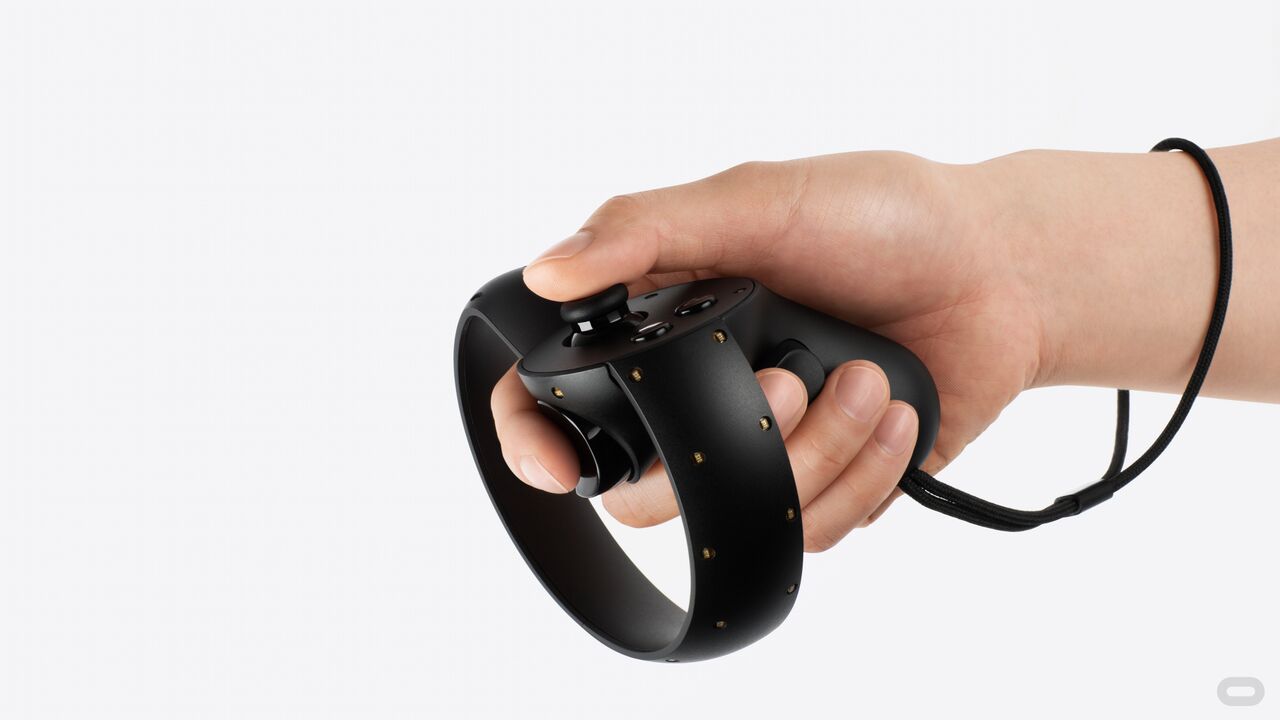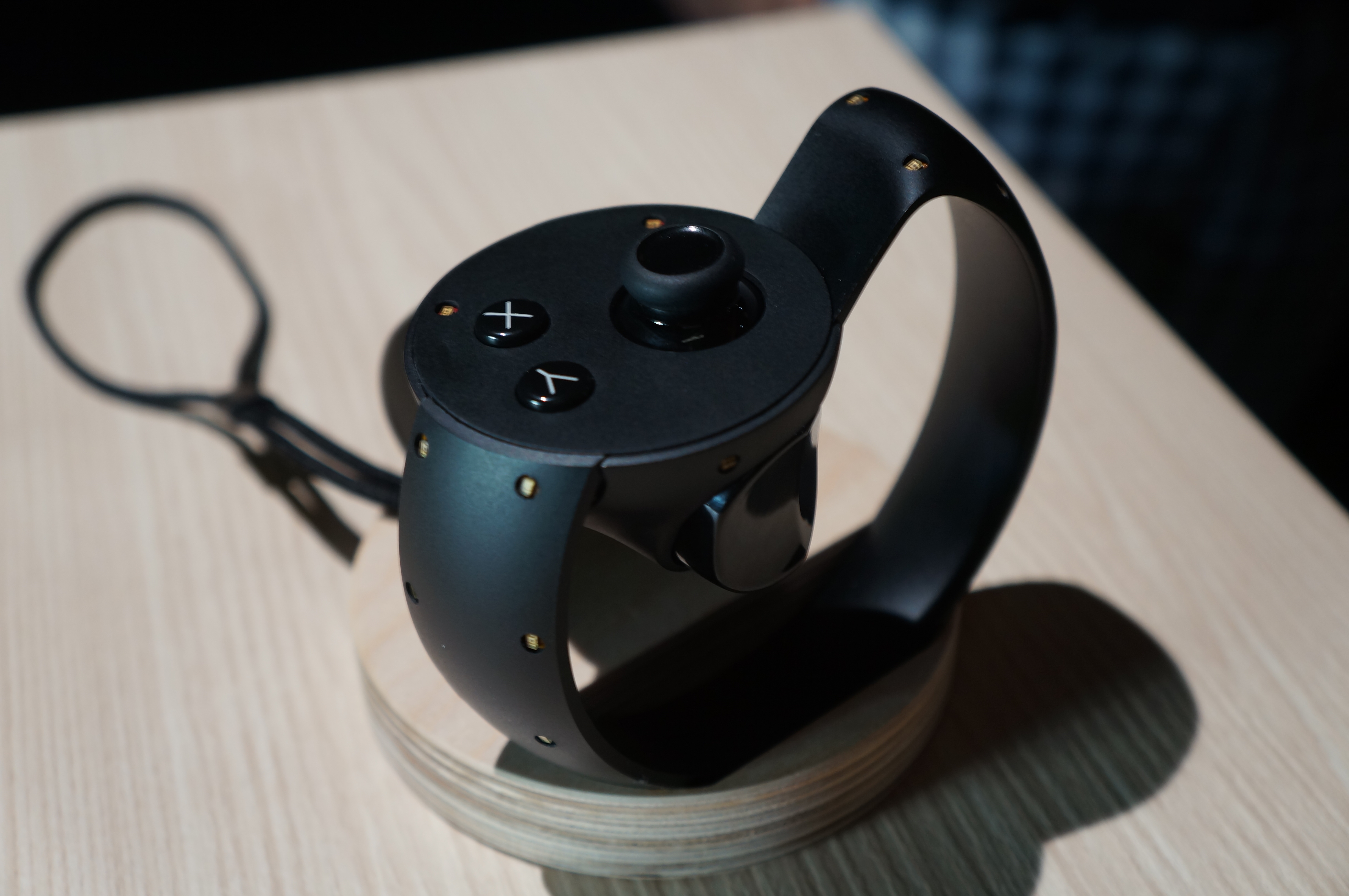The Oculus Touch is an intuitive, exciting VR controller

In March, I wrote that Valve’s SteamVR hardware had surpassed the Oculus Rift, largely because of its fantastic VR controllers. Valve’s controllers are wands, a bit like the PlayStation Move, but with zero (or at least undetectable) latency and incredibly precise tracking. Now, at E3 2015, Oculus has finally shown what it’s been cooking up for VR control: the Oculus Touch. I’ve spent 10 minutes using the Touch controllers to throw virtual blocks, fire virtual slingshots, and set off virtual firecrackers. I hit a virtual tether ball at Palmer Luckey’s face. That was pretty cool.
A few hours removed from the experience, I can confidently say that the Oculus Touch feels like a closer analogue to the human hand than Valve’s VR controllers. It was intuitive enough to feel like an extension of my hand, and natural enough for me to stop thinking about the fact that I was holding a controller for short stretches of the demonstration. Like the best VR experiences I’ve had, Oculus’ toybox demo prompted a few big, stupid grins on my face. And toybox is absolutely about showing off the Oculus Touch’s strengths.
Before I get to toybox, a quick rundown of the wireless Touch controllers. As you can tell from a photo of the Oculus Touch, the top of the controller has a small analog stick and a pair of face buttons. The underside is a bit harder to see. Your index and middle fingers rest on a pair of triggers on the bottom side of the controller, which contain sensors to detect some basic finger motions, like pointing. You grip the controller with a rounded nub, like one of the wings of the PlayStation’s Dualshock. The controllers, like the headset, are tracked via a bunch of infrared LEDs and the camera that faces you in a Rift setup.
The Touch controllers fit well in my hands—their small size, and the way the grip fit into my palm, is why they feel so intuitive to use. With Valve’s wand controllers, pulling a trigger as a synonym for “grabbing” feels more like pressing a button. But with the Oculus Touch, pulling the middle finger trigger to grab replicates the motion of making a fist.
Palmer Luckey walked me through Oculus VR’s toybox demo at E3, each of us strapped into a Rift in separate soundproofed booths. The toybox is basically a physics playground. In one part of the demo, we picked up blocks and tossed them around, set off fireworks and sparklers with a lighter, and smacked a tetherball with our fists and heads. Since the Rift headset’s position is tracked in space, just like the controllers, headbutting works just as well as punching.

It’s really hard to overstate how joyful it is just to interact with even simple objects like this in VR using your hands. It just feels real, even if your brain isn’t convinced that these simple polygonal blocks and pyramids and low-poly toy robots are real objects. It’s the interaction that feels real. I didn’t realize quite how quickly and thoroughly I’d adapted to the controls until Luckey started giving me suggestions, and I responded to them naturally. He didn’t say “press the trigger to pick this block up” or “move your finger off the trigger to flick this block.” He said “Hey, pick up that block,” and I just did it. He said “watch this,” and flicked a block, and I instinctively flicked my finger out to do the same thing. And I flicked the block.
Man, that is a cool feeling.
Keep up to date with the most important stories and the best deals, as picked by the PC Gamer team.
The rest of the toybox was just as fun. I discovered that I’m a terrible aim when I fired a virtual gun. I was even worse with the slingshot, which I gripped in one hand, using the other hand’s trigger to pull back on the cord and let fly.
The one part that left me unconvinced brought the analog stick into the mix. I controlled a small RC tank, using the joystick to drive it while aiming its cannon with the pointer. Driving the tank from my perspective and having to account for its orientation was a bit confusing, but that wasn’t the controller’s fault—that one small slice of a tech demo Oculus has been using to test out dozens of actions just didn’t quite do it for me. But it left me wondering how those traditional controls will suit other games. I think the buttons and joystick might be a tad small, but I already want to spend more time with the Touch to see if it can replace an Xbox controller for more traditional games.
As if using the Oculus Touch wasn’t convincing enough, I had a blast watching Palmer’s virtual hands, floating disembodied in the toybox demo, manipulating these controllers. He’s clearly spent thousands of hours wielding these controllers like...well, his own hands. He picked up and interacted with objects like a hyperactive VR maestro. When he pulled up a radial dev menu to cycle through objects to spawn into the world, he cycled through them in a matter of seconds. Imagine the confident routine of a skilled short order chef who’s cracked eggs into a skillet ten million times using the exact same motion.
Now imagine being able to do something that naturally in VR. That is something to be excited about.
As I wrote earlier, I think the Oculus Touch feels like a more natural extension of your hand than Valve’s VR controllers. But I don’t think that automatically makes them the better, or best, controllers for VR. Valve’s controllers were great, too, and it’ll take some close side-by-side scrutiny to compare latency, tracking accuracy, and so on. Valve’s trackpad button is a unique interface, while the Oculus Touch’s analog sticks might make it fit more traditional games more easily. I’m excited to see different types of games developed to fit the different controllers.
Bottom line, Oculus Touch is good for VR, because it means whichever VR headset you choose, you’ll have a controller genuinely fit for virtual reality.

Wes has been covering games and hardware for more than 10 years, first at tech sites like The Wirecutter and Tested before joining the PC Gamer team in 2014. Wes plays a little bit of everything, but he'll always jump at the chance to cover emulation and Japanese games.
When he's not obsessively optimizing and re-optimizing a tangle of conveyor belts in Satisfactory (it's really becoming a problem), he's probably playing a 20-year-old Final Fantasy or some opaque ASCII roguelike. With a focus on writing and editing features, he seeks out personal stories and in-depth histories from the corners of PC gaming and its niche communities. 50% pizza by volume (deep dish, to be specific).

